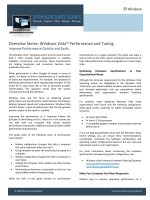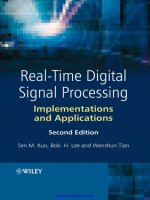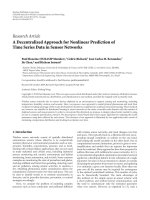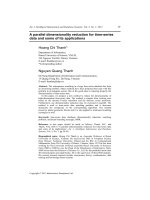Practical time series analysis master time series data processing, visualization, and modeling using python
Bạn đang xem bản rút gọn của tài liệu. Xem và tải ngay bản đầy đủ của tài liệu tại đây (14.1 MB, 285 trang )
Practical Time Series Analysis
Master Time Series Data Processing, Visualization, and Modeling
using Python
Dr. Avishek Pal
Dr. PKS Prakash
>
BIRMINGHAM - MUMBAI
Practical Time Series Analysis
Copyright © 2017 Packt Publishing
All rights reserved. No part of this book may be reproduced, stored in a
retrieval system, or transmitted in any form or by any means, without the
prior written permission of the publisher, except in the case of brief
quotations embedded in critical articles or reviews.
Every effort has been made in the preparation of this book to ensure the
accuracy of the information presented. However, the information contained in
this book is sold without warranty, either express or implied. Neither the
authors, nor Packt Publishing, and its dealers and distributors will be held
liable for any damages caused or alleged to be caused directly or indirectly by
this book.
Packt Publishing has endeavored to provide trademark information about all
of the companies and products mentioned in this book by the appropriate use
of capitals. However, Packt Publishing cannot guarantee the accuracy of this
information.
First published: September 2017
Production reference: 2041017
Published by Packt Publishing Ltd.
Livery Place
35 Livery Street
Birmingham
B3 2PB, UK.
ISBN 978-1-78829-022-7
www.packtpub.com
Credits
Authors
Copy Editor
Dr. Avishek Pal
Tasneem Fatehi
Dr. PKS Prakash
Reviewer
Project Coordinator
Prabhanjan Tattar
Manthan Patel
Commissioning Editor
Proofreader
Veena Pagare
Safis Editing
Acquisition Editor
Indexer
Aman Singh
Tejal Daruwale Soni
Content Development Editor
Graphics
Snehal Kolte
Tania Dutta
Technical Editor
Production Coordinator
Danish Shaikh
Deepika Naik
About the Authors
Dr. Avishek Pal, PhD, is a software engineer, data scientist, author, and an
avid Kaggler living in Hyderabad, the City of Nawabs, India. He has a
bachelor of technology degree in industrial engineering from the Indian
Institute of Technology (IIT) Kharagpur and has earned his doctorate in 2015
from University of Warwick, Coventry, United Kingdom. At Warwick, he
studied at the prestigious Warwick Manufacturing Centre, which functions as
one of the centers of excellence in manufacturing and industrial engineering
research and teaching in UK.
In terms of work experience, Avishek has a diversified background. He
started his career as a software engineer at IBM India to develop middleware
solutions for telecom clients. This was followed by stints at a start-up product
development company followed by Ericsson, a global telecom giant. During
these three years, Avishek lived his passion for developing software solutions
for industrial problems using Java and different database technologies.
Avishek always had an inclination for research and decided to pursue his
doctorate after spending three years in software development. Back in 2011,
the time was perfect as the analytics industry was getting bigger and data
science was emerging as a profession. Warwick gave Avishek ample time to
build up the knowledge and hands-on practice on statistical modeling and
machine learning. He applied these not only in doctoral research, but also
found a passion for solving data science problems on Kaggle.
After doctoral studies, Avishek started his career in India as a lead machine
learning engineer for a leading US-based investment company. He is
currently working at Microsoft as a senior data scientist and enjoys applying
machine learning to generate revenue and save costs for the software giant.
Avishek has published several research papers in reputed international
conferences and journals. Reflecting back on his career, he feels that starting
as a software developer and then transforming into a data scientist gives him
the end-to-end focus of developing statistics into consumable software
solutions for industrial stakeholders.
I would like to thank my wife for putting up with my late-night writing
sessions and weekends when I had to work on this book instead of going out.
Thanks also goes to Prakash, the co-author of this book, for encouraging me
to write a book.
I would also like to thank my mentors with whom I have interacted over the
years. People such as Prof. Manoj Kumar Tiwari from IIT Kharagpur and
Prof. Darek Ceglarek, my doctoral advisor at Warwick, have taught me and
showed me the right things to do, both academically and career-wise.
Dr. PKS Prakash is a data scientist and author. He has spent the last 12
years in developing many data science solutions in several practice areas
within the domains of healthcare, manufacturing, pharmaceutical, and ecommerce. He is working as the data science manager at ZS Associates. ZS is
one of the world's largest business services firms, helping clients with
commercial success by creating data-driven strategies using advanced
analytics that they can implement within their sales and marketing operations
in order to make them more competitive, and by helping them deliver an
impact where it matters.
Prakash's background involves a PhD in industrial and system engineering
from Wisconsin-Madison, US. He has earned his second PhD in engineering
from University of Warwick, UK. His other educational qualifications
involve a masters from University of Wisconsin-Madison, US, and bachelors
from National Institute of Foundry and Forge Technology (NIFFT), India. He
is the co-founder of Warwick Analytics spin-off from University of Warwick,
UK.
Prakash has published articles widely in research areas of operational
research and management, soft computing tools, and advance algorithms in
leading journals such as IEEE-Trans, EJOR, and IJPR among others. He has
edited an issue on Intelligent Approaches to Complex Systems and
contributed in books such as Evolutionary Computing in Advanced
Manufacturing published by WILEY and Algorithms and Data Structures
using R and R Deep Learning Cookbook published by PACKT.
I would like to thank my wife, Dr. Ritika Singh, and daughter, Nishidha
Singh, for all their love and support. I would also like to thank Aman Singh
(Acquisition Editor) of this book and the entire PACKT team whose names
may not all be enumerated but their contribution is sincerely appreciated and
gratefully acknowledged.
About the Reviewer
Prabhanjan Tattar is currently working as a Senior Data Scientist at Fractal
Analytics Inc. He has 8 years of experience as a statistical analyst. Survival
analysis and statistical inference are his main areas of research/interest, and
he has published several research papers in peer-reviewed journals and also
authored two books on R: R Statistical Application Development by
Example, Packt Publishing, and A Course in Statistics with R, Wiley. The R
packages, gpk, RSADBE, and ACSWR are also maintained by him.
www.PacktPub.com
For support files and downloads related to your book, please visit www.PacktPub
.com.
Did you know that Packt offers eBook versions of every book published, with
PDF and ePub files available? You can upgrade to the eBook version at www.P
acktPub.com and as a print book customer, you are entitled to a discount on the
eBook copy. Get in touch with us at for more details.
At www.PacktPub.com, you can also read a collection of free technical articles,
sign up for a range of free newsletters and receive exclusive discounts and
offers on Packt books and eBooks.
/>
Get the most in-demand software skills with Mapt. Mapt gives you full
access to all Packt books and video courses, as well as industry-leading tools
to help you plan your personal development and advance your career.
Why subscribe?
Fully searchable across every book published by Packt
Copy and paste, print, and bookmark content
On demand and accessible via a web browser
Customer Feedback
Thanks for purchasing this Packt book. At Packt, quality is at the heart of our
editorial process. To help us improve, please leave us an honest review on
this book's Amazon page at />If you'd like to join our team of regular reviewers, you can e-mail us at
We award our regular reviewers with free eBooks
and videos in exchange for their valuable feedback. Help us be relentless in
improving our products!
Table of Contents
Preface
What this book covers
What you need for this book
Who this book is for
Conventions
Reader feedback
Customer support
Downloading the example code
Errata
Piracy
Questions
1.
Introduction to Time Series
Different types of data
Cross-sectional data
Time series data
Panel data
Internal structures of time series
General trend
Seasonality
Run sequence plot
Seasonal sub series plot
Multiple box plots
Cyclical changes
Unexpected variations
Models for time series analysis
Zero mean models
Random walk
Trend models
Seasonality models
Autocorrelation and Partial autocorrelation
Summary
2.
Understanding Time Series Data
Advanced processing and visualization of time series data
Resampling time series data
Group wise aggregation
Moving statistics
Stationary processes
Differencing
First-order differencing
Second-order differencing
Seasonal differencing
Augmented Dickey-Fuller test
Time series decomposition
Moving averages
Moving averages and their smoothing effect
Seasonal adjustment using moving average
Weighted moving average
Time series decomposition using moving averages
Time series decomposition using statsmodels.tsa
Summary
3.
Exponential Smoothing based Methods
Introduction to time series smoothing
First order exponential smoothing
Second order exponential smoothing
Modeling higher-order exponential smoothing
Summary
4.
Auto-Regressive Models
Auto-regressive models
Moving average models
Building datasets with ARMA
ARIMA
Confidence interval
Summary
5.
Deep Learning for Time Series Forecasting
Multi-layer perceptrons
Training MLPs
MLPs for time series forecasting
Recurrent neural networks
Bi-directional recurrent neural networks
Deep recurrent neural networks
Training recurrent neural networks
Solving the long-range dependency problem
Long Short Term Memory
Gated Recurrent Units
Which one to use - LSTM or GRU?
Recurrent neural networks for time series forecasting
Convolutional neural networks
2D convolutions
1D convolution
1D convolution for time series forecasting
Summary
6.
Getting Started with Python
Installation
Python installers
Running the examples
Basic data types
List, tuple, and set
Strings
Maps
Keywords and functions
Iterators, iterables, and generators
Iterators
Iterables
Generators
Classes and objects
Summary
Preface
This book is about an introduction to time series analysis using Python. We
aim to give you a clear overview of the basic concepts of the discipline and
describe useful techniques that would be applicable for commonly-found
analytics use cases in the industry. With too many projects requiring trend
analytics and forecasting based on past data, time series analysis is an
important tool in the knowledge arsenal of any modern data scientist. This
book will equip you with tools and techniques, which will let you confidently
think through a problem and come up with its solution in time series
forecasting.
Why Python? Python is rapidly becoming a first choice for data science
projects across different industry sectors. Most state-of-the art machine
learning and deep learning libraries have a Python API. As a result, many
data scientists prefer Python to implement the entire project pipeline that
consists of data wrangling, model building, and model validation. Besides,
Python provides easy-to-use APIs to process, model, and visualize time series
data. Additionally, Python has been a popular language for the development
of backend for web applications and hence has an appeal to a wider base of
software professionals.
Now, let's see what you can expect to learn from every chapter this book.
What this book covers
Introduction to Time Series, starts with a discussion of the three
different types of datasets—cross-section, time series, and panel. The
transition from cross-sectional to time series and the added complexity of
data analysis is discussed. Special mathematical properties that make time
series data special are described. Several examples demonstrate how
exploratory data analysis can be used to visualize these properties.
Chapter 1,
Understanding Time Series Data, covers three topics, advanced
preprocessing and visualization of time series data through resampling,
group-by, and calculation of moving averages; stationarity and statistical
hypothesis testing to detect stationarity in a time series; and various methods
of time series decomposition for stationarizing a non-stationary time series.
Chapter 2,
Exponential Smoothing based Methods, covers smoothing-based
models using the Holt-Winters approach for first order to capture levels,
second order to smoothen levels and trend, and higher order smoothing is
illustrated, which captures level, trend, and seasonality within a time series
dataset.
Chapter 3,
Auto-Regressive Models, discusses autoregressive models for
forecasting. The chapter covers a detailed implementation for moving
average (MA), autoregressive (AR), Auto Regressive Moving Average
(ARMA), and Auto Regressive Integrated Moving Average (ARIMA) to
capture different levels of nuisance within time series data during forecasting.
Chapter 4,
Deep Learning for Time Series Forecasting, discusses recent deep
learning algorithms that can be directly adapted to develop forecasting
models for time series data. Recurrent Neural Networks (RNNs) are a natural
choice for modeling sequence in data. In this chapter, different RNNs such as
Vanilla RNN, Gated Recurrent Units, and Long Short Term Memory units
are described to develop forecasting models on time series data. The
mathematical formulations involved in developing these RNNs are
Chapter 5,
conceptually discussed. Case studies are solved using the ‘keras’ deep
learning library of Python.
Getting Started with Python, you will find a quick and easy
introduction to Python. If you are new to Python or looking for how to get
started with the programming language, reading this appendix will help you
get through the initial hurdles.
Appendix,
What you need for this book
You will need the Anaconda Python Distribution to run the examples in this
book and write your own Python programs for time series analysis. This is
freely downloadable from />The code samples of this book have been written using the Jupyter Notebook
development environment. To run the Jupyter Notebooks, you need to install
Anaconda Python Distribution, which has the Python language essentials,
interpreter, packages used to develop the examples, and the Jupyter Notebook
server.
Who this book is for
The topics in this book are expected to be useful for the following people:
Data scientists, professionals with a background in statistics, machine
learning, and model building and validation
Data engineers, professionals with a background in software
development
Software professionals looking to develop an expertise in generating
data-driven business insights
Conventions
In this book, you will find a number of text styles that distinguish between
different kinds of information. Here are some examples of these styles and an
explanation of their meaning.
A block of code is set as follows:
import os
import pandas as pd
%matplotlib inline
from matplotlib import pyplot as plt
import seaborn as sns
In-text code is highlighted in font and color as here: pandas.DataFrame. File and
folder names are also shown in the same style, for example,
Chapter_1_Models_for_Time_Series_Analysis.ipynb or datasets/DJIA_Jan2016_Dec2016.xlsx
At several places in the book, we have referred to external URLs to cite
source of datasets or other information. A URL would appear in the
following text style:
New terms and important words are shown in bold. Words that you see on
the screen, for example, in menus or dialog boxes, appear in the text like this:
"In order to download new modules, we will go to Files | Settings | Project
Name | Project Interpreter."
Warnings or important notes appear like this.
Tips and tricks appear like this.
Reader feedback
Feedback from our readers is always welcome. Let us know what you think
about this book-what you liked or disliked. Reader feedback is important for
us as it helps us develop titles that you will really get the most out of. To send
us general feedback, simply email , and mention the book's
title in the subject of your message. If there is a topic that you have expertise
in and you are interested in either writing or contributing to a book, see our
author guide at www.packtpub.com/authors.
Customer support
Now that you are the proud owner of a Packt book, we have a number of
things to help you to get the most from your purchase.
Downloading the example code
You can download the example code files for this book from your account at
. If you purchased this book elsewhere, you can visit http://
www.packtpub.com/support and register to have the files emailed directly to you.
You can download the code files by following these steps:
1.
2.
3.
4.
5.
6.
7.
Log in or register to our website using your email address and password.
Hover the mouse pointer on the SUPPORT tab at the top.
Click on Code Downloads & Errata.
Enter the name of the book in the Search box.
Select the book for which you're looking to download the code files.
Choose from the drop-down menu where you purchased this book from.
Click on Code Download.
Once the file is downloaded, please make sure that you unzip or extract the
folder using the latest version of:
WinRAR / 7-Zip for Windows
Zipeg / iZip / UnRarX for Mac
7-Zip / PeaZip for Linux
The code bundle for the book is also hosted on GitHub at />ublishing/Practical-Time-Series-Analysis. We also have other code bundles from our
rich catalog of books and videos available at />Check them out!
Errata
Although we have taken every care to ensure the accuracy of our content,
mistakes do happen. If you find a mistake in one of our books-maybe a
mistake in the text or the code-we would be grateful if you could report this
to us. By doing so, you can save other readers from frustration and help us
improve subsequent versions of this book. If you find any errata, please
report them by visiting selecting your book,
clicking on the Errata Submission Form link, and entering the details of your
errata. Once your errata are verified, your submission will be accepted and
the errata will be uploaded to our website or added to any list of existing
errata under the Errata section of that title. To view the previously submitted
errata, go to and enter the name of the
book in the search field. The required information will appear under the
Errata section.









